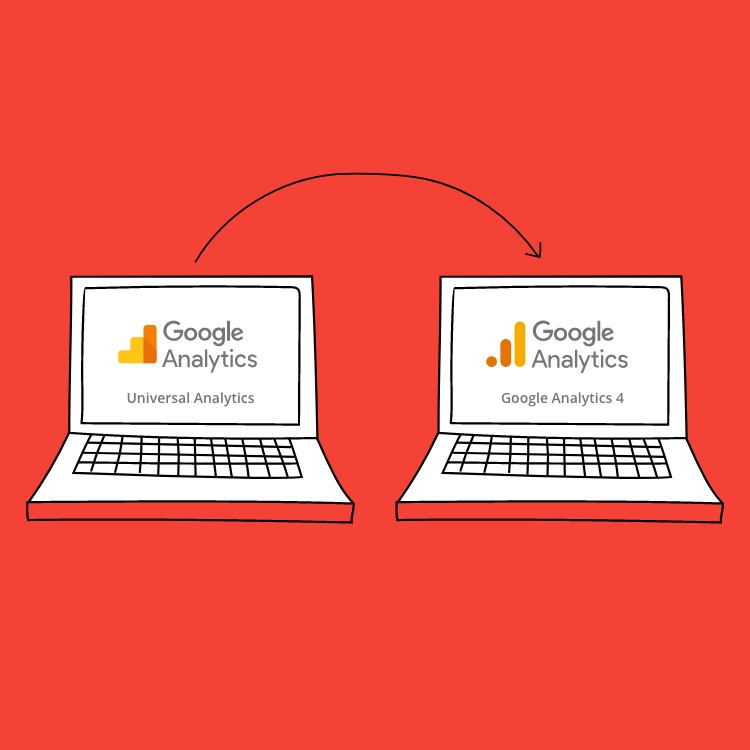Digital marketing performance metrics or KPIs are crucial in a world where data reigns supreme, and helps to evaluate the effectiveness of your digital marketing efforts. Join us as we unpack the top 8 KPIs that you need to be regularly measuring, including:

1: Website traffic
The total number of visits to your website is more than just a number; it’s a window into the online behaviour of your audience. Understanding where your traffic comes from, how users navigate your site, and which pages attract the most attention can provide valuable insights into your audience’s interests and preferences, making it a useful KPI. Google Analytics 4 and Google Search Console are great tools to help you find relevant data, alongside Ubersuggest and SEM Rush.
As well as this you can try to benchmark your website traffic against industry standards to help gauge your performance and identify areas for improvement, as shown with Databox’s industry benchmark breakdown.
2: Conversion rate
While driving traffic to your website is essential, the ultimate goal is to convert those visitors into leads or customers. This is where conversion rate comes into play, by tracking the percentage of visitors who complete a desired action, whether it’s making a purchase, filling out a form, or signing up for a newsletter, you can measure the effectiveness of your website in turning visitors into valuable prospects. This can be configured and tracked using tools such as; Google Tag Manager and Google Analytics 4.
Benchmarks for conversion rates vary across industries, so it’s important to compare your performance against similar businesses to assess your competitiveness in the market.
3: Click-through rate (CTR)
When it comes to online advertising, getting users to click on your ads or find you through organic search is half the battle. The click-through rate (CTR) measures the percentage of people who clicked on an ad or organic search result, and indicates the relevance and appeal of your content to your target audience. A high CTR suggests that your ad, content or organic search resonates well with users, compelling them to take action. However, achieving a good CTR requires more than just catchy copy and compelling visuals; it also involves strategic targeting and placement to ensure your content reaches the right audience, at the right time.
While benchmarks for CTR can vary depending on the platform and industry, a CTR of 3% or higher is generally considered ‘good’, and it’s this type of KPI that you need to be measuring consistently. As a digital marketing agency, we’ve got plenty of experience helping businesses boost their CTR and drive engagement towards their content, get in touch to learn more.

4: Cost per click (CPC)
What’s equally important to getting clicks when it comes to digital marketing performance metrics, is effectively managing your advertising budget, in other words cost per click or CPC. Although, this only comes into play if you decide to advertise, and if you don’t, this should allow you to become more competitive. CPC measures the average cost for each click on an ad, helping you assess the cost-effectiveness of your advertising campaigns.
A lower CPC indicates that you’re getting more bang for your buck, maximising the value of your advertising spend. And as an overall benchmark, the higher the volume and lower the CPC the better.
5: Return on investment (ROI)
ROI measures the revenue generated from a marketing campaign relative to its cost, providing valuable insights into its profitability. By regularly keeping an eye on this KPI and actively tracking ROI, you can assess the effectiveness of your marketing efforts and allocate resources more efficiently to maximise returns.
Calculating ROI requires tracking all costs associated with a campaign, including advertising spend, labour costs, and overhead expenses, and comparing them to the revenue generated from that campaign. As a general benchmark, a positive ROI indicates that the campaign is generating more revenue than it costs to run, while a negative ROI suggests that adjustments may be needed to improve its profitability. Ultimately, the success of any marketing campaign boils down to one question: Is it generating a positive return on investment (ROI)?
6: Website engagement
Yes, much like everything in today’s modern world, it all boils down to attention, but not just that, capturing and retaining the interest of your audience. Engagement rate measures the percentage of visitors who spend more time on your website. A ‘high’ website engagement rate, which used to be referred to as a ‘bounce rate’ in Google Analytics, but has since changed allowing us to measure with a glass half full method, indicates that your content is resonating well with your audience, fostering deeper connections and brand loyalty.
As a general benchmark, a ‘good’ engagement rate is between 40-60%.

7: Social media engagement
Social media has become an indispensable tool for marketers looking to connect with their audience on a more personal level. However, success on social media isn’t just about the number of followers you have; it’s about the level of engagement you can generate. Social media engagement encompasses likes, shares, comments, and other interactions on platforms like Facebook, X, and Instagram, reflecting the effectiveness of your content and its resonance with your audience.
By measuring this type of KPI, you can assess the impact of your social media efforts and adjust strategies accordingly to drive more meaningful interactions and conversations with your audience. Using tools such as; Google Analytics and Hootsuite Analytics is a great way to measure, track and report your social media engagement.
8: Email open rate
Email marketing remains one of the most effective channels for reaching and engaging with your audience, which is why it is used by over 31% of marketers today. However, getting users to open your emails is the first hurdle you need to overcome. The email open rate measures the percentage of people who opened an email, providing insights into the effectiveness of your email campaigns in capturing attention. A high open rate indicates that your subject lines are compelling and relevant to your audience, enticing them to click through and engage with your content.
Benchmarks for email open rates can vary depending on factors such as industry, audience demographics, and email frequency, which Mailchimp have broken down here.

While these 8 metrics serve as fundamental indicators of your KPIs, it’s important to remember that the specific metrics most relevant to your business will depend on your goals, industry, and chosen marketing channels. Regular analysis of these metrics can provide valuable insights into your performance and help you refine your strategies for better results over time.
Need support in analysing the key metrics of your digital channels and require a strategy of how they should work moving forward? Get in touch today.
FAQs
How do I optimise my website to improve my digital presence?
- Focus on improving website speed, mobile responsiveness, and user experience.
- Conduct keyword research and optimise content for search engines.
- Utilise analytics to track website performance and make data-driven optimizations.
How do I know if my business is performing on social media?
- Monitor key metrics such as engagement rate, reach, and follower growth.
- Use social media analytics tools to track performance and identify trends.
- Compare your performance against industry benchmarks to gauge effectiveness.
How can I use AI to help improve my digital strategy?
- Utilise AI-powered tools for data analysis, personalisation, and automation.
- Implement chatbots for customer service and lead generation.
- Use AI algorithms to optimise advertising campaigns and content targeting.
Should I be using personalisation to enhance my digital presence?
- Yes, personalisation can significantly enhance user experience and engagement.
- Tailor content, product recommendations, and marketing messages to individual preferences.
- Use customer data and behaviour analysis to deliver personalised experiences across channels.
Are there any digital trends I should be aware of for 2024?
From the continued rise of video content and live streaming, to content marketing diversification, there’s plenty of digital marketing trends for 2024 that we’re looking forward to seeing how they play out. Read our blog on the latest trends for more.




